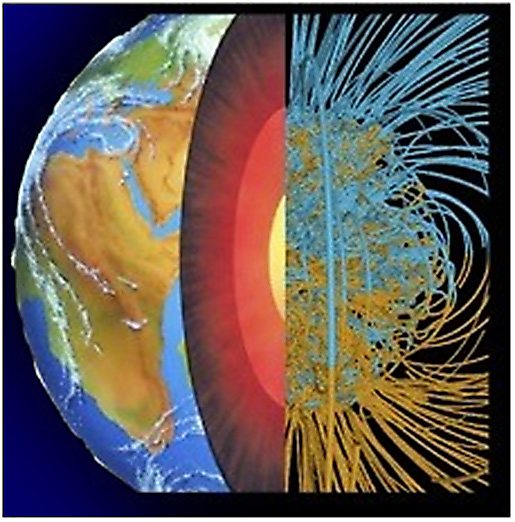
Credit: Dr. Peter Olson, Computational Infrastructure for Geodynamics, Johns Hopkins University.
You may remember that our magnetic field forms a protective bubble around Earth called the magnetosphere. It keeps solar winds and cosmic rays from scouring away our atmosphere, and protects spacecraft, satellites, astronauts, and air travelers.
But where does the magnetic field come from?
The inner core of Earth is very, very hot—about 6,000°C, the same as the surface of the sun.
At that temperature, you’d expect it to be liquid or even gas. But because the pressure at the core is so extraordinary, about 2 million times what it is on the surface, the inner core stays solid. In fact, it’s 85 percent solid iron.
The outer core of Earth is also mostly iron, but because the pressure is lower, it’s liquid.
As lighter elements, at different temperatures, gradually rise through the liquid iron, they cause convection currents to form, like cream swirling in your coffee. Meanwhile, Earth’s rotation causes spinning eddies to develop.
This somewhat-organized circulation of liquid metal creates electric currents, which charge Earth’s iron core, turning it into a giant electromagnet.
The magnetic field in the core is thought to be more than 10 times stronger than on the surface —and strong enough to extend 400,000 miles into space. Which is what allows it to protect us from the hazards of space.
Background
Synopsis: Circulation in Earth's molten outer core creates a giant dynamo that generates our magnetosphere to safeguard us from solar and cosmic radiation.
- The metallic core behaves as Earth’s dynamo and generates our magnetic field.
- What is a dynamo? In the 17th century, scientists proved that when an electric current moves around a magnet, it intensifies the magnetic field. They called the phenomenon a dynamo and used it in early electrical generators.
- Temperatures at the core of Earth are almost as hot as on the surface of the sun, at about 6,000°C. Pressures at the core are 2 million times more than on the planet’s surface.
- These extreme pressures keep the inner core solid—it is about two-thirds the size of the moon and is 85 percent iron, a naturally magnetic material. The outer core is more than seven times the volume of the moon.
- With slightly lower pressures than the inner core, the outer core consists of an electrically conducting metallic fluid.
- Like what you see when you mix cold cream into hot coffee, convection currents form in the liquid outer core because of temperature and compositional contrasts as lighter elements rise toward Earth’s surface from the slowly solidifying inner core.
- Swirling eddies also develop because of the Coriolis effect caused by the rotational spin of Earth.
- This organized circulation generates electrical currents that produce the self-sustaining geodynamo of our magnetic field.
- Compared to the surface, the magnetic field at the core is thought to be around 50 times stronger.
- Scientists believe Earth had an even stronger magnetic field early in its history, enabling it to retain the gases that formed its early atmosphere, essential to life.
- The core of Earth creates the conditions that make it habitable for you and me! It protects the atmosphere, spacecraft, satellites, and our electronic devices.

